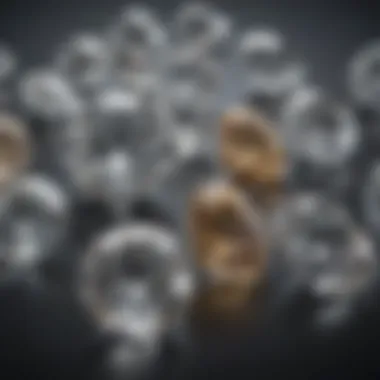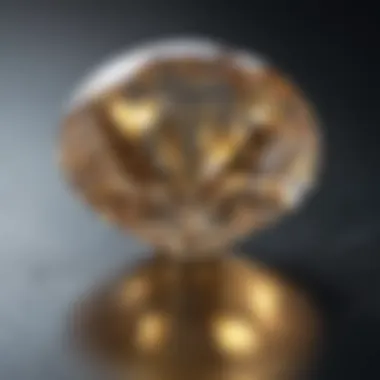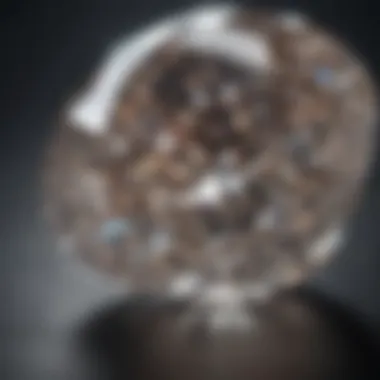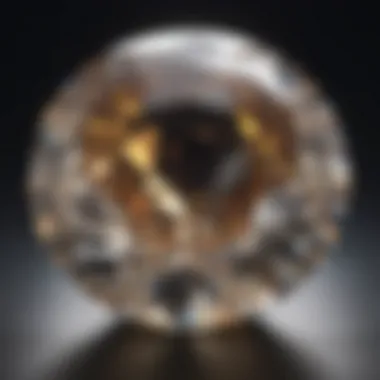Assessing the Value of Your Diamond: A Comprehensive Guide


Intro
Assessing the value of a diamond can seem daunting, yet it is an essential journey for gemstone enthusiasts and collectors. A diamond’s worth is influenced by multiple factors, making it important to grasp these dynamics. This guide is designed to enlighten readers on the key elements involved in diamond valuation. Understanding the inherent characteristics of diamonds and how they determine value can bolster one’s confidence in making informed decisions.
Gemstone Overview
Definition and Characteristics
Diamonds are crystalline forms of carbon. They are renowned for their brilliance and durability. A diamond's unique properties stem from its internal structure and the way it interacts with light. Notable characteristics include:
- Hardness: Diamonds are rated 10 on the Mohs scale of hardness. This makes them the hardest natural substance.
- Brilliance: The cut of the diamond affects how light reflects and refracts within it, contributing to its overall appearance.
- Color: Diamonds come in a variety of colors, which can dramatically affect their value. Most diamonds are graded on a scale from colorless to shades of yellow or brown.
- Clarity: This reflects the internal and external imperfections in a diamond. The fewer the flaws, the higher the clarity grade.
Classification of Gemstones
Diamonds fall into the category of precious gemstones, distinguished by rarity and aesthetic appeal. They are often classified based on their origin:
- Natural Diamonds: Formed over millions of years deep within the Earth under high pressure and temperature.
- Synthetic Diamonds: Manufactured in labs, mimicking the characteristics of natural diamonds.
- Fancy Color Diamonds: These diamonds exhibit unique colors and are classified based on hue, intensity, and tone.
Historical Significance
Ancient Uses and Cultural Importance
Throughout history, diamonds have been treasured. Ancient civilizations recognized their rarity and beauty. They were used as talismans, believed to possess protective qualities. In India, diamonds were considered as embodiments of powers and truths. In more recent times, gems have played a vital role in royal engagements and adornment, symbolizing love and commitment.
Myths and Legends Surrounding Gemstones
Legends around diamonds often revolve around their supposed mystical properties. Folklore suggests that diamonds bring luck and prosperity, while others claim they can protect from evil spirits. These myths underline the enduring mystique and cultural significance of diamonds, sustaining their allure through centuries.
"Diamonds are a reflection of both beauty and durability, making them timeless treasures."
Understanding these aspects not only heightens appreciation for diamonds but also lays the groundwork for a thorough analysis of their value in today’s market.
Understanding Diamond Valuation
An in-depth understanding of diamond valuation is critical for anyone involved in the world of gemstones. Diamonds, often regarded as the pinnacle of luxury and wealth, require precise evaluation to determine their worth. This discussion will explain key elements, benefits, and considerations regarding this essential topic.
Understanding how valuation works allows collectors, gem enthusiasts, and jewelry designers to make informed decisions, whether they are buying or selling. Without this knowledge, one risks undervaluing a diamond or, conversely, overpaying for what might not be worth the investment. In this guide, we will outline core concepts and practical implications for assessing a diamond's value in an evolving market.
The Basics of Diamond Pricing
Diamond pricing is influenced by various factors, and it’s vital to grasp these fundamentals. The price of a diamond is not a straightforward matter of weight or size. It incorporates several criteria, most notably the four Cs: cut, color, clarity, and carat weight. Each of these elements contributes differently to the overall value.
- Cut: Refers to how well the diamond is shaped and faceted. A well-cut diamond reflects light optimally, enhancing its brilliance and thus its market value.
- Color: Graded on a scale from D (colorless) to Z (light yellow). Generally, the less color, the higher the value.
- Clarity: Assessing the absence of blemishes and inclusions; diamonds with fewer imperfections command higher prices.
- Carat Weight: Larger diamonds are rarer and typically more expensive, but price increases are not linear with weight.
Moreover, market dynamics affect pricing as well. Demand and supply significantly sway the price of diamonds, making it crucial for buyers and sellers to stay informed.
The Role of Gemological Laboratories
Gemological laboratories play a pivotal role in the diamond valuation process. These institutions assess diamonds and assign certifications that outline their properties based on established grading standards. When purchasing or selling a diamond, a certificate from a reputable laboratory adds credibility to the valuation.
The presence of a recognized certification — such as those from the Gemological Institute of America (GIA) or the American Gem Society (AGS) — can enhance the saleability of a diamond. Knowing that a diamond has been assessed by an expert can provide buyers with greater confidence and can often influence the final transaction price.
Certifications detail essential attributes of a diamond, helping buyers to compare options effectively. This structured analysis ensures transparency and reassures buyers about the quality they are investing in. Furthermore, understanding this aspect of valuation can protect against fraud, aiding consumers in navigating a sometimes convoluted marketplace.
"A diamond's true value often lies beyond its carat weight and involves a nuanced interplay of quality factors."
The Four Cs of Diamonds
The Four Cs—cut, color, clarity, and carat weight—represent the essential criteria for assessing the value of a diamond. Understanding these factors is crucial for anyone seeking to evaluate a diamond’s worth accurately. Each element contributes uniquely to a diamond's allure and monetary value. This layered approach ensures that gemstone enthusiasts, collectors, and jewelry designers can make informed decisions in the marketplace.
Cut Quality
Significance of Cut


The cut of a diamond governs how it reflects light, which directly influences its sparkle and overall visual appeal. A well-cut diamond will exhibit brilliance and fire, making it a highly sought-after characteristic for buyers. The key feature of cut quality is precision.
Precision enhances the interplay of light within a diamond, ensuring maximum brightness. A diamond that is cut poorly may lose its brilliance, which can significantly lower its market value. In the context of this article, understanding the significance of cut enables buyers to differentiate between various diamond quality levels.
Different Cut Grades
Cut grades assess the quality of the diamond’s shape and proportions. There are several grades, including Excellent, Very Good, Good, Fair, and Poor. Each grade offers unique insights into how light is handled within the stone. Higher grades reflect superior craftsmanship, which adds to the diamond’s overall value.
The characteristic of cut grades lies in their ability to categorize diamonds based on technical proficiency in cutting. A diamond with an Excellent cut grade can command a premium price due to its enhanced beauty. Awareness of these grades helps consumers navigate purchasing decisions and appraisals effectively.
Color Grading
Understanding Color Scales
Color grading attempts to measure the hue of a diamond, using a scale ranging from D (colorless) to Z (light yellow). The key characteristic is clarity of color, which enhances the stone's rarity. Diamonds that fall between grades D and F are particularly valued for their near-colorless appearance.
Identifying the nuances on the color scale is essential for buyers. Color plays a fundamental role in determining value, as more colorless diamonds are more desirable. Thus, comprehending color scales allows customers to appreciate variations and make sound purchasing decisions.
Impact on Value
The color of a diamond significantly impacts its value, with colorless diamonds generally fetching higher prices. The unique feature here is the rarity associated with each color grade. For instance, diamonds graded D, E, and F are often perceived as luxury items. Buyers must consider how color affects overall aesthetics and worth.
Understanding the relationship between color grading and market value can guide collectors and enthusiasts in their investments.
Clarity Assessment
Types of Inclusions
Inclusions refer to internal flaws within a diamond that can affect its clarity. There are various types, such as feathers, crystals, and clouds. The key characteristic of inclusions is their visibility, which can either diminish or enhance a diamond's uniqueness.
Recognizing the types of inclusions helps buyers evaluate clarity. While some buyers may prefer diamonds without inclusions, others might find charm in character marks. Clarity assessment is vital for understanding what makes each diamond unique.
Clarity Grades Explained
Clarity grades categorize diamonds based on the presence and visibility of inclusions. These include categories like Flawless, Internally Flawless, and various degrees of Slightly Included to Included. The benefit of clarity grading is that it provides a clear framework for comparing diamonds effectively.
A higher clarity grade indicates fewer inclusions and greater visual appeal. For individuals seeking to assess quality, being aware of these grades ensures informed decisions about the investment potential of a diamond.
Carat Weight Considerations
Weight vs. Value Relation
Carat weight directly influences a diamond’s size and is often proportionate to its price. Larger diamonds are rare and command significantly higher prices, making weight a critical aspect in valuation. The key characteristic here is the perception of size—larger diamonds are generally more desirable.
Understanding this relationship is vital for potential buyers. Consumers must weigh the size factor against other C factors to ensure they make a balanced investment.
Market Trends in Carat Weight
Market trends show fluctuating demands for various carat weights over time. Currently, there's a growing interest in larger stones due to trends in fashion and personal preference. The unique feature of this aspect is how consumer preferences can shift, impacting market value.
Monitoring these trends allows both buyers and sellers to anticipate fluctuations and strategize accordingly. Keeping an eye on market movements can lead to better decision-making when it comes to buying or selling diamonds.
Additional Factors Influencing Value
Evaluating the value of a diamond goes beyond the Four Cs. While Cut, Color, Clarity, and Carat weight are fundamental elements in determining worth, other factors also play a significant role in the overall price of a diamond. Understanding these factors is essential whether one plans to sell, appraise, or insure a diamond.
Certificate Importance
Recognizing Trustworthy Certifications
A diamond certificate is a document attesting to a diamond's characteristics and authenticity. Certificates from recognized gemological laboratories like the Gemological Institute of America (GIA) or the American Gem Society (AGS) are pivotal in the diamond industry. Their reputation for meticulous research provides trust and assurance to buyers. The presence of a valid certificate can significantly impact a diamond's perceived value.
Key characteristics of trustworthy certifications include:
- Detailed Information: These certificates provide specific data on the diamond’s attributes.
- Expert Evaluation: They come from professionals trained in accurate grading and assessment.
This evaluation is beneficial for potential buyers. It ensures that the diamond meets specific quality standards and minimizes the risk of fraud. Without a recognized certification, a diamond's value can be questioned. Dealing in certified diamonds typically attracts buyers more confidently.
The Impact of Certification on Value
Certification directly influences a diamond's market value. For a diamond with a good certification, the expected price is inevitably higher. The grading report highlights its characteristics and assures buyers of its quality. A well-graded diamond not only attracts higher bids but also commands respect in the marketplace.
The characteristics of certified diamonds include:
- Increased Demand: Diamonds with certificates are sought after.
- Resale Value: Reselling certified diamonds becomes easier and often more profitable.
Yet, the challenge lies in understanding that not all certifications hold equal weight. Certifications from lesser-known laboratories may not enhance value as effectively as those from leading organizations.
Market Demand and Supply
Understanding Market Fluctuations


Market dynamics greatly influence the value of diamonds. The diamond market experiences ebbs and flows based on various factors. Seasonal demands, economic trends, and consumer behavior all contribute to market fluctuations. Understanding these fluctuations can be beneficial in timing a sale or purchase.
One key aspect is seasonal trends. For instance, diamonds see increased demand around holidays and significant life events.
- Economic Influences: Factors like consumer spending power or changes in luxury spending can shift demand.
- Global Events: Natural calamities or political changes can also alter supply lines, impacting availability.
By being aware of these trends, sellers and buyers can make well-informed decisions about when to engage in buying or selling diamonds.
Identifying Trends in Consumer Preferences
The preferences of consumers evolve over time. Identifying these trends is crucial for anyone involved in the diamond market. Popular cuts, styles, or ethical sourcing practices can lead to shifts in demand.
For example, currently, there is a growing trend toward sustainable and ethically sourced diamonds.
Key points in consumer trends include:
- Style Preferences: Modern styles may be favored over traditional options.
- Ethical Concerns: More consumers are prioritizing ethically sourced diamonds, influencing their purchasing decisions.
As trends shift, values may also change accordingly. For sellers, understanding these preferences can aid in pricing strategies and determining inventory.
Provenance and History
Historical Significance of Diamonds
The historical context of a diamond can urge its value higher beyond its physical attributes. Diamonds with historical significance or those that were once owned by notable individuals often carry enhanced value. The stories behind these diamonds can allure collectors and increase market demand.
Several points illustrate the significance of a diamond’s history:
- Cultural Value: Certain diamonds link to specific cultures or events, adding layers to their worth.
- Celebrity Association: Diamonds owned by or gifted to celebrities often fetch higher prices in auctions.
While historical significance cannot guarantee higher market prices, it does create added interest and can justify a premium.
Effects of Previous Ownership on Value
The notion of previous ownership can substantially influence a diamond's value. A diamond that has a well-documented history, particularly if previously owned by prominent figures, tends to be valued higher. This is often due to the perceived prestige associated with ownership.
Factors that contribute to this affect include:
- Provenance Records: Clarity about a diamond’s past reinforces its value.
- Buyer Interest: Some buyers may specifically seek diamonds with unique ownership tales or histories.
However, not all previous ownership enhances value. Diamonds with negative associations may see a drop in price. Thus, while provenance adds value in many cases, context is crucial.
Methods for Appraising Your Diamond
Understanding how to appraise your diamond is crucial for determining its value in the marketplace. Various methods exist, each offering different insights and assessments. By exploring these methods, you can make better-informed decisions whether you want to buy, sell, or simply understand the worth of your stone. Two primary approaches are DIY valuation techniques and professional appraisals. Each offers advantages and shines light on various aspects of diamond valuation.
DIY Valuation Techniques
Utilizing Online Resources
Utilizing online resources for diamond valuation has become increasingly common. These resources include websites, forums, and diamond valuation calculators that present valuable data. A key characteristic of online resources is convenience and accessibility. They provide quick insights into estimated values based on various parameters of the diamond, like carat weight and clarity.
Using sites such as En.wikipedia.org or britannica.com can help you learn more about diamond grading systems and industry standards. However, it is crucial to remember that while online resources can offer general insights, they do not replace professional evaluations. The unique feature of these tools is that they are user-friendly and sometimes free, making them a popular option for individuals looking to gather preliminary information about their diamond's worth. The main disadvantage might be the variability in accuracy, as these tools can only provide estimates based on the data input, which can be misleading if miscalibrated.
The Role of Averages in Valuation
The role of averages in valuation is another significant aspect of DIY methods. By calculating average prices of similar diamonds based on different characteristics, you can gain informative insights into how your diamond compares to typical market values. This method is not only beneficial but also practical for quick assessments before making any decisions.
Averages give you a solid groundwork from which to start negotiations. The unique feature here is the ability to pull general statistics from vast databases, which aggregates prices based on size, quality, and other significant factors. However, a key drawback is that averages may not account for peculiarities specific to your diamond, like unique inclusions or sentimental value that can significantly affect worth.
Professional Appraisal Process
What to Expect from an Appraiser
When engaging a professional appraiser, specific expectations should guide your approach. A thorough appraisal will involve a hands-on examination of your diamond, where the appraiser will assess its various characteristics following standardized grading criteria. This professional service not only provides a detailed report on your diamond’s value but also imparts credible verification for resale purposes.


The key characteristic of professional appraisals is thoroughness; they usually include equipment and methods that DIY techniques lack. Moreover, the experience of the appraiser can help clarify the intricate details of your diamond that may not be immediately obvious. However, consider that this service can be costly. Engaging an appraiser does come with a price, and it is essential to ensure that the potential increase in value justifies the expense.
Cost Implications of Professional Appraisals
The cost implications of professional appraisals can vary significantly. Some appraisers charge a flat fee, while others may work on a percentage basis linked to the diamond's value. Understanding this can help you decide on the most suitable service for your needs.
A vital consideration here is the balance between cost and value you gain. While the appraisal can often lead to a higher sale price, the upfront cost could be a barrier for some.
On the positive side, professional appraisals can significantly enhance perceived value when selling or insuring your diamond. However, always ensure you choose a reputable appraiser to avoid inflated appraisals that do not reflect true market conditions or characteristics.
Selling Your Diamond
Selling a diamond involves several important factors. Understanding these factors can significantly increase the chances of making a profitable sale. This section focuses on the process of selling a diamond, the platforms available, and the negotiation strategies that can be employed. Each aspect has its intricacies, and comprehending them is vital for anyone looking to realize the value of their diamond.
Choosing the Right Platform
Choosing the right platform to sell a diamond can greatly affect the selling experience and outcome. Each platform has its own characteristics that can influence the sale process.
Online Marketplaces
Online marketplaces offer a wide reach that can connect sellers to potential buyers from around the globe. The key characteristic of these platforms is accessibility; they are open 24/7 and often provide user-friendly interfaces for listing items. Websites like eBay and Etsy are popular choices among those looking to sell diamonds.
The unique feature of online marketplaces is the ability to showcase the diamond through detailed photographs and descriptions. Sellers can reach a larger audience without geographical limitations. However, there are disadvantages. For instance, it can be challenging to establish trust with buyers. Additionally, sellers may incur fees that can lower their profit margin.
Local Jewelers and Auctions
Local jewelers and auction houses present another option for selling diamonds. One key characteristic is the personal interaction involved. Selling through these venues often entails face-to-face discussions, allowing sellers to convey the diamond’s uniqueness or provenance directly.
The unique feature of local jewelers is their established credibility in the community. They can provide immediate cash offers, often simplifying the transaction process. However, local jewelers may offer less than what could be achieved through online sales due to their profit margins. Moreover, auctions can be unpredictable, as the final sale price relies heavily on bidding dynamics.
Negotiating the Sale
Negotiation techniques are critical during the diamond selling process. Understanding how to navigate buyer interactions can lead to better outcomes.
Understanding Buyer Psychology
Understanding buyer psychology is quite significant in negotiating a sale. Knowing what motivates a buyer can enhance approach strategies. For instance, buyers often seek assurance of quality and value. Highlighting certifications and past appraisals underscores the diamond’s worth.
The key characteristic of understanding buyer psychology is the ability to tailor communication to address buyer concerns effectively. A seller who demonstrates empathy towards the buyer’s needs can create a more favorable negotiating environment. The downside is that it requires careful observation and attentiveness to nuances, which can be challenging.
Strategic Pricing Approaches
Strategic pricing approaches involve determining the right asking price based on various factors like market conditions and similar diamond sales. Price positioning can significantly influence buyer interest. A well-researched price creates a sense of fairness and transparency.
One key aspect of this strategy is flexibility. Sellers should be prepared to adjust their prices based on buyer feedback or market trends. A balanced approach encourages potential buyers to engage in discussions rather than dismissing offers outright. On the flip side, pricing too high may lead to prolonged selling times, while pricing too low could undermine perceived value.
"In diamond selling, the choice of platform and negotiation techniques can profoundly impact the final sale outcome."
Understanding Market Trends
Understanding market trends is crucial for effectively assessing the value of diamonds. The diamond market does not exist in a vacuum; it is influenced by a variety of external factors that can fluctuate the value of diamonds over time. Recognizing these trends equips consumers and sellers with essential wisdom to make informed decisions regarding purchases or sales. This understanding can help in determining the best timing for selling or buying, as well as evaluating the potential future value of a diamond.
Current Diamond Market Insights
The current market conditions for diamonds are influenced by several key factors, including global economic conditions, consumer behavior, and cultural shifts. Notably, the demand for ethically sourced diamonds has grown, reflecting consumer interest in sustainability. The luxury sector has shown resilience, continuing to attract buyers despite economic fluctuations. Moreover, social media and digital marketing play significant roles in shaping consumer preferences, offering insights into trending styles or types of diamonds that may boost visibility and value in the market.
Future Predictions
As we look ahead, several predictions can be made regarding the diamond market. These forecasts can offer insights applicable for both buyers and sellers, guiding them in their decisions.
Emerging Trends
Emerging trends point towards a more conscious consumer. There is an increasing demand for lab-grown diamonds, which are often seen as a more sustainable and ethical option. This shift reflects broader environmental concerns. The key characteristic of these lab-grown diamonds is their nearly identical composition to natural diamonds, yet they are generally more affordable. Understanding this trend can help buyers who hold concerns about sustainability make informed choices. However, the perceived value in the luxury market can vary, presenting both advantages and disadvantages when considering resale.
Technological Innovations in Diamond Selling
Technological innovations are significantly impacting how diamonds are marketed and sold. Online sales platforms now provide more accessibility for buyers and sellers alike. One unique feature of these platforms is the integration of augmented reality, which allows customers to virtually try on jewelry from the comfort of their homes. This innovation is beneficial for retailers aiming to reach a broader audience and enhances the shopping experience. Nevertheless, the reliance on technology contributes to challenges associated with establishing trust and authenticity.
"The future of diamonds intertwines increasingly with technological advancements alongside evolving consumer preferences, shaping market dynamics in unprecedented ways."
In summary, understanding market trends not only informs valuation but also unveils opportunities and potential pitfalls. For gemstone enthusiasts and collectors, staying attuned to these insights ensures wise purchasing and selling strategies.







